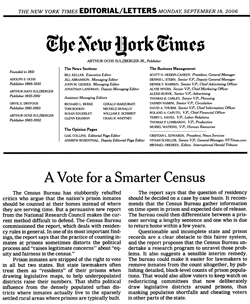A Vote for a Smarter Census — New York Times editorial
by New York Times, September 18, 2006
 The Census Bureau has stubbornly rebuffed critics who argue that the nation’s prison inmates should be counted at their homes instead of where they are serving time. But a persuasive new report from the National Research Council makes the current method difficult to defend. The Census Bureau commissioned the report, which deals with residency rules in general. In one of its most important findings, the report says that the practice of counting inmates at prisons sometimes distorts the political process and “raises legitimate concerns” about “equity and fairness in the census.”
The Census Bureau has stubbornly rebuffed critics who argue that the nation’s prison inmates should be counted at their homes instead of where they are serving time. But a persuasive new report from the National Research Council makes the current method difficult to defend. The Census Bureau commissioned the report, which deals with residency rules in general. In one of its most important findings, the report says that the practice of counting inmates at prisons sometimes distorts the political process and “raises legitimate concerns” about “equity and fairness in the census.”
Prison inmates are stripped of the right to vote in all but two states. But state lawmakers often treat them as “residents” of their prisons when drawing legislative maps, to help underpopulated districts raise their numbers. That shifts political influence from the densely populated urban districts where inmates actually live to the sparsely settled rural areas where prisons are typically built.
The report says that the question of residency should be decided on a case by case basis. It recommends that the Census Bureau gather information on time spent in prison and expected date of release. The bureau could then differentiate between a prisoner serving a lengthy sentence and one who is due to return home within a few years.
Questionable and incomplete state and prison records are a clear obstacle to this fairer system, and the report proposes that the Census Bureau undertake a research program to unravel those problems. It also suggests a sensible interim remedy. The bureau could make it easier for lawmakers to remove inmates from the count altogether, by publishing detailed, block-level counts of prison populations. That would also allow voters to keep watch on redistricting committees that now deliberately draw legislative districts around prisons, thus masking population shortfalls and cheating voters in other parts of the state.



